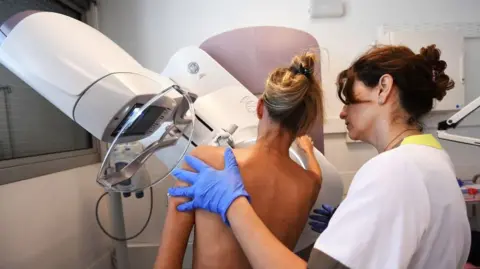Men should help carry out mammograms - experts
 Getty Images
Getty ImagesMale health workers should be allowed to perform breast screening examinations to help relieve staff shortages, say experts.
X-rays called mammograms are offered to women between the age of 50 and 71 every three years to check for signs of cancer, but can currently only be performed by female staff.
The Society of Radiographers (SoR) has called for a change in policy due to "critical" staff shortages among radiographers who specialise in this area.
Sally Reed, 67, who had two mastectomies after mammograms revealed breast cancer, told the BBC that "if something can save your life you should go for it" - whether it's administered by a woman or man.
But Sally also admits women who already don't want to go for breast screening "would definitely be turned off by a man".
Breast X-rays, which look for cancers that are too small to see or feel, are only permitted to be undertaken by female health workers. Mammography is the only health examination carried out exclusively by female staff.
According to radiographers, the vacancy rate among mammographers who specialise in breast exams is 17.5%.
Among mammographers who assess women who have found a lump in their breast or have a family history of breast cancer, the figure is 20%.
It takes three to four years to qualify as a radiographer through a university degree.
Changes to staffing were being discussed at the annual SoR conference, with discussions also taking place over whether transgender men should be included in the NHS breast screening programme.
Sue Johnson, who represents the SoR, told the BBC: "The role of the radiographer has developed and evolved and there is a much broader scope to the job role than simply taking the images.
"It's a very desirable and enjoyable career and men are saying 'we would like to access that same career and we could help deliver the service'".
Johnson said she believes this could help the recruitment of more radiographers and open up the job to more qualified people because "mammography doesn't get as much publicity" as other health professions.
The prospect of men performing mammograms has been explored unsuccessfully in the past, but Johnson believes "the world has changed" and that "the time is right" to start reconsidering the role.
She says women would still be given a choice on who conducted their mammogram if they didn't feel comfortable with a man doing it.
Ms Reed said having two mammograms 15 years apart were responsible for "saving" her life.
She's now had two mastectomies after two separate breast cancer diagnoses.
Because of what she's gone through, having a male radiographer "wouldn't bother me at all", she says.
But Claire Rowney, chief executive of charity Breast Cancer Now, says "it's vital that efforts to build up the screening workforce do not inadvertently damage uptake of breast screening".
She says that "while we welcome every effort to reduce staff shortages and delays in breast screening, we know that concerns about being seen by a male mammographer already deter some women from attending breast screening, even with current staffing being all-female".
Ms Rowney adds that recruiting male mammographers could be an issue for some women in ethnic minority communities, who may have greater concerns around preserving their modesty and who may be less likely to take up the offer of screening.
